Yoga for Menopause (+ The Best Poses for Symptom Relief)
In a hurry? Click here to read the Article Summary...
Suffering from hot flashes, mood swings, aching joints, insomnia, and/or tiredness and lethargy related to menopause? We’ve covered essential oils that can provide relief from hot flashes and other issues experienced during menopause. Today, we’re discussing yoga for menopause and how it, too, can help to ease many of the more troublesome signs & symptoms of menopause.
What Is Menopause?
A woman is considered to be in menopause when she has not had a menstrual period for one year. The transition generally takes several years; however, the phase leading up to it is called perimenopause.
Perimenopause typically occurs in women between the ages of 45 to 55. Fluctuating levels of the hormones progesterone and estrogen can spark many uncomfortable symptoms during this time. Complicating matters is the fact that symptoms of menopause are complex and can differ greatly from woman to woman. Some women experience a whole host of issues (both mental and physical), while others barely notice the change.
Common Signs & Symptoms of Menopause
The most commonly encountered signs and symptoms of menopause are:
- hot flashes
- irritability
- insomnia
- memory problems
- anxiety
- depression
- fatigue
- erratic menstrual cycle
For some women, symptoms are so severe that they can feel they’re going crazy. Sadly, in days gone by, there were women actually committed to mental asylums while undergoing the “change of life”!
Menopause is a time of metamorphosis, a transitional time in a woman’s life that offers many new freedoms and benefits. It need not become a medical condition – especially when there are so many health-promoting options (such as doing yoga exercises for menopause!) that can help minimize some of the more uncomfortable aspects.
Why Yoga for Menopause? 3 Reasons
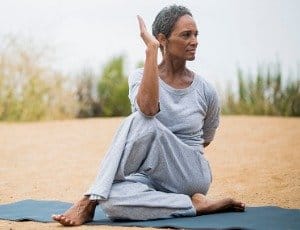
Many women going through menopause notice that when they regularly attend their yoga classes, their menopausal symptoms are much better. Yoga and menopause are a great match for 3 key reasons:
- Yoga has the ability to relax and calm the nervous system by influencing the secretion of neurotransmitters like GABA and serotonin.
- Certain yoga postures stimulate the vasomotor center, a portion of the brain that, together with the heart, blood vessels, and lungs, regulates blood pressure, hormone levels, and many other processes.
- Certain yoga postures directly influence the endocrine system and have a balancing effect on hormonal levels.
These three factors alone can play an enormous role in helping to ease menopausal symptoms. But what does the research tell us? Although a number of studies have investigated whether yoga can be helpful for managing menopausal symptoms, the results have been mixed.
Some of the studies that have been done are hampered by inconsistency in the types of practices utilized and the methods by which the researchers measured their outcomes. Although we have an imperfect understanding of how yoga helps (i.e., how it actually makes changes in the body), it is obvious from the trials that have been done that it DOES help.
Yoga for Menopause & Perimenopause: What the Research Shows
Reduced frequency & intensity of hot flashes
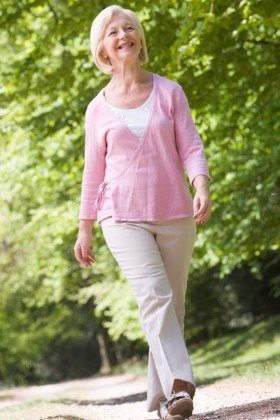
A 2007 study analyzed how yoga might affect menopausal symptoms. Around 160 menopausal women were divided into three groups: one group participated in yoga, one group took part in a walking program, and one group did nothing.
The results showed that the women in both the yoga and walking groups had similar benefits, which included reduced frequency and intensity of hot flashes, improved sleep, diminished anxiety, and better-perceived quality of life [1].
Less anxiety
A 2010 study at Boston University School of Medicine found that women who practiced yoga three times per week for 12 weeks had significantly higher levels of gamma-aminobutyric acid (GABA) (a neurotransmitter that has a calming effect on the nervous system) and less anxiety than the group not practicing yoga [2].
Better sexual function
In a 2014 study, participants were divided into three groups. One group was asked to do a yoga routine both in a class and at home; one group was asked to do aerobic exercise training three times per week; and one group was asked to do their regular activity, but to also take omega-3 fats three times daily.

All participants were asked to complete a Menopause Quality of Life questionnaire. They answered questions about sleep quality, levels of pain, stress, and activity, sexual function, depression, anxiety, the prevalence of hot flash interference with daily activities, and enjoyment of life.
These questions were asked at the beginning of the study, and again after 12 weeks had elapsed. Compared to the groups doing aerobic exercise or omega-3 supplementation, those in the yoga group reported improved quality of life, better sexual function, and fewer hot flashes after 12 weeks [3].
Improved quality of life
Brazilian scientists investigated the serum estrogen levels of healthy post-menopausal women undertaking four months of twice-weekly one-hour yoga classes. They found that engaging in yoga naturally increased estrogen levels for these women and improved their quality of life [4].
Beneficial for psychological symptoms
A 2017 meta-analysis of research on yoga investigated the effectiveness of yoga, tai chi, and qi gong on vasomotor (actions upon a blood vessel that alter its diameter), psychological symptoms, and quality of life in peri- and post-menopausal women.
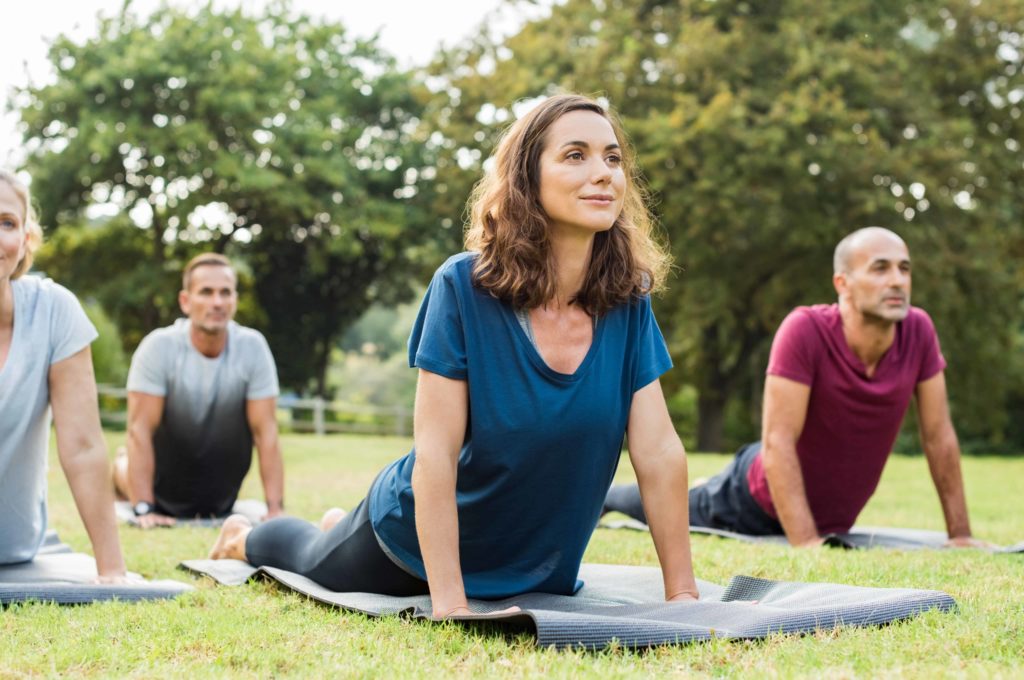
The authors of the meta-analysis were unable to find any such studies for tai chi and qi gong but reviewed a number of high-quality trials that included yoga. They concluded that “Results from this meta-analysis suggest that yoga may be a useful therapy to manage bothersome vasomotor and psychological symptoms [5].”
Yoga for Menopausal Women with Breast Cancer
Yoga has also shown benefits for the menopausal symptoms experienced by those going through breast cancer. It not only promotes a stronger immune system but also relieves stress and tension, helps to balance hormones, and improves sleep.
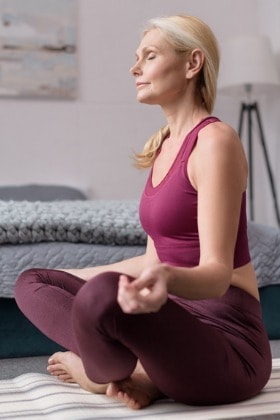
A 2008 study investigated whether yoga could reduce the menopausal symptoms encountered by early-stage breast cancer survivors. In this study, 37 participants in the test group were free of cancer, and some were on tamoxifen, a commonly prescribed hormone therapy that can exacerbate menopausal symptoms.
The test group took part in two-hour guided yoga sessions as well as home practice for two months. The program included yoga poses and stress reduction techniques. All of the women reported a significant reduction in hot flashes, joint pain, sleep disturbances, and fatigue [6].
The Best Yoga Positions for Menopause Symptom Relief
Want to tailor a personalized yoga practice to ease your particular menopausal symptoms? Below you will find a list of common symptoms, along with the particular yoga poses or types of poses that are most likely to aid with that symptom.
If you are unfamiliar with a pose, please consult a trusted yoga teacher or website such as yogajournal.com for instruction. Good sites and instructors will not only guide you through how to correctly do each pose but will also provide further information, such as contraindications and how each pose can help with other facets of health.
Hot Flashes
If you’ve ever been to a yoga class, you’ll know that the instructor will not only show you how to get into a particular posture but will also instruct how to breathe through it. This type of deeper, mindful breathing is important. It has been found to reduce the frequency and intensity of hot flashes.
Also, because yoga reduces stimulatory neurotransmitters like norepinephrine (noradrenaline) and boosts GABA, a calming neurotransmitter, this also helps to reduce the incidence and intensity of hot flashes.
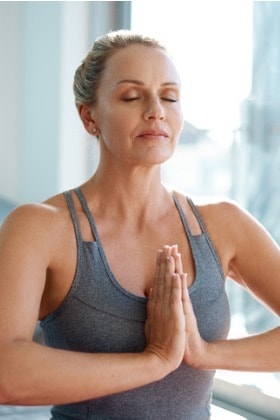
Helpful Yoga Poses: When you feel a hot flash starting up, slow your movements. Pay close attention to your breath and slow it down as well. Standing poses such as Mountain Pose, Tree Pose, and Eagle help to calm the nerves and cool hot flashes.
Supported reclining poses also help to calm the nerves and promote relaxation. Try Reclining Bound Angle Pose or Reclining Hero Pose, which open the chest and abdomen, allowing tightness to ease, which has a calming effect.
Night Sweats
Night sweats are terribly disruptive to sleep. Some women joke that they lead to doing “blanket aerobics” (blanket on, blanket off!). Others describe the pleasure of finding that “cold spot” on the sheets on which they can lie for relief.
A regular yoga practice reduces blood pressure, which in turn promotes better circulation and oxygenation to the organs of the body. Practicing yoga regularly also has a balancing effect on the endocrine system – the end result being fewer night sweats.
Helpful Yoga Poses: Corpse Pose and Legs-Up-the-Wall Pose are both relaxing postures that can be very helpful for night sweats. Be sure to direct your focus to your breath and not on how hot you may feel.
Aches and Pains
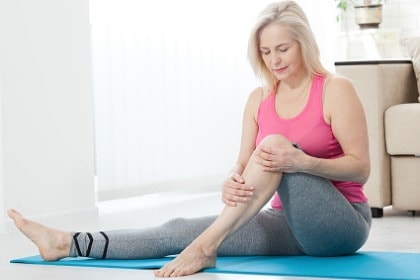
Aching knees, elbows, wrists, back, and neck tend to result from declining estrogen levels because estrogen plays a huge role in the health of joints and connective tissues like tendons and ligaments. The slow and gentle stretching performed in yoga can make a huge difference in reducing pain levels.
Helpful Yoga Poses: Almost all of them! One pose that is particularly helpful for back and neck pain is Half Lord of the Fishes Pose, a gentle spinal twist. Also beneficial for aching, painful muscles are Bound Angle Pose, Cat/Cow, Dolphin, Downward Facing Dog, Low Lunge, Plow, and Sun Salutation.
If you find that holding a pose hurts, just back off the intensity or find another, gentler way to do the pose. This is where a qualified yoga instructor can be of enormous assistance to you.
Anxiety & Irritability
The hormonal fluctuations encountered during peri- and post-menopause are known to cause anxiety, irritability, and nervous tension. During this time, the adrenal glands can become depleted by constantly having to respond to lack of sleep, stress, poor dietary choices, etc. Nourishing poses for the adrenals are beneficial.
Helpful Yoga Poses: Forward bends, especially with the head resting on a bolster or prop, help to support the adrenals and ease the nervous system into a state of rest, thus quieting overworked adrenals. Try Big Toe Pose, Standing Forward Bend, Seated Forward Bend, and Wide-Legged Forward Bend.
Fatigue / Lethargy
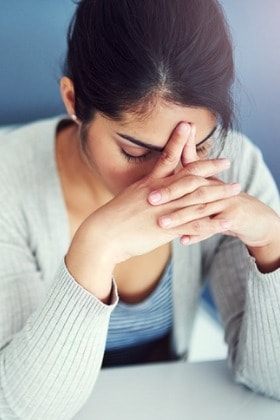
Second only to hot flashes in the degree of annoyance they cause, fatigue and lethargy are rampant amongst post-menopausal women. Sometimes it can be difficult to tell whether it’s depression masked as fatigue or vice versa. Again, falling hormone levels are usually to blame.
Helpful Yoga Poses: Supported backbends can be of assistance because they open the chest and heart area, restore circulation, thus lifting the spirits and increasing energy. Try Reclining Bound Angle Pose and Reclining Hero. Pranayama Breathing, a particular method of breathing, increases oxygen and brings instant energy.
Depression and Mood Swings
Because menopause signals the end of a woman’s childbearing years and/or children leaving home, it can be a difficult time for many women. While not meant to be a replacement for psychotherapy in cases of clinical depression, yoga can definitely assist mild cases of the blues or feeling melancholy.
Helpful Yoga Poses: All of them. Especially backbends because they stimulate and massage the adrenal glands. Backbends also encourage better blood and oxygen circulation in the heart and lungs. Bridge Pose is restorative; it helps to calm the brain and ease stress and mild depression. Yoga teachers also promote inversions for depression. Try Big Toe Pose, Dolphin, and Downward Facing Dog. There appears to be something about being upside down that has a positive effect on mood, boosts circulation to the brain, and helps ease anxiety and depression.
Disturbed Sleep / Insomnia
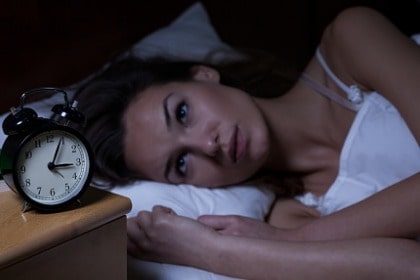
A 2014 study found that yoga significantly improved sleep and quality of life for older people with insomnia [7].
Helpful Yoga Postures: All restorative poses are helpful, especially Reclining Bound Angle and Corpse Pose. Hero Pose aids with calm and relaxation, encourages better quality sleep and deeper sleep. Big Toe Pose and Legs-Up-The-Wall Pose, done prior to bed (and also useful in the middle of the night when those hot flashes awaken), can calm and promote sleep.
Brain Fog
If you’ve noticed that you’re losing your clarity of thought, such as wandering into a room and thinking “Why am I here?” or you just can’t remember that name that’s on the tip of your tongue, yoga can assist here as well.
Especially helpful are inversions – where the upper body and head are lower than the heart. Inversions promote better circulation to the brain, help to balance the hypothalamus and pituitary glands, and clear out the mental “cobwebs.”
Helpful Yoga Postures: Try Downward-Facing Dog, Standing Forward Bend, and Wide-Legged Forward Bend. Pranayama breathing also improves mental acuity and alertness.
Muscle Atrophy and Bone Health
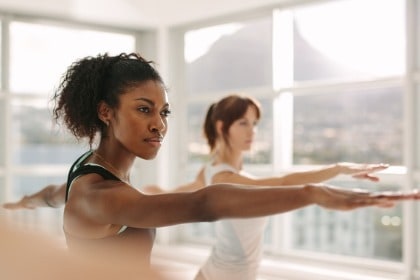
Yoga teachers working with menopausal women have reported that combining weight-bearing poses with restorative poses works synergistically. Not only does it improve some of the muscle-wasting that can occur with menopause, but this combination of yoga poses for menopause has a direct effect on bone density.
Helpful Yoga Postures: Any weight-bearing poses such as Downward-Facing Dog, Sun Salutation, and Warrior Pose.
Heavy Menstrual Bleeding
Certain yoga postures can help to settle and relax the pelvic area, which can help to slow or ease heavy periods. Only restorative poses should be used during times of heavy menstrual bleeding.
Helpful Yoga Postures: Try Reclining Bound Angle, Bound Angle Pose, Reclining Hero Pose, and Easy Pose – all of which can be extremely beneficial.
The Best Yoga Poses for Menopause and Their Benefits
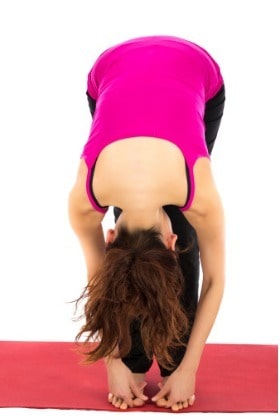
Big Toe Pose (Padangusthasana)
Physical Benefits – Stretches hamstrings and calves, strengthens thighs, improves digestion, stimulates the liver, helps relieve headaches, good for insomnia.
Mental Benefits – Calms the nervous system; eases stress and anxiety.
Bound Angle Pose (Baddha Konasana)
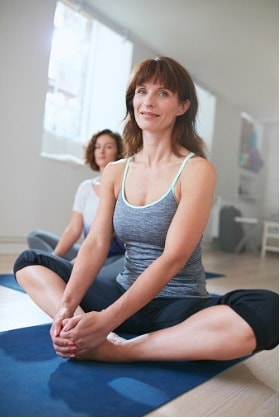
Physical Benefits – Stretches inner thighs and knees, soothes menstrual discomfort, relieves menopausal symptoms, improves cardiovascular function, eases low back pain and sciatica.
Mental Benefits – Helps ease depression, anxiety, and fatigue.
Bridge Pose (Setu Bandha Sarvangasana)
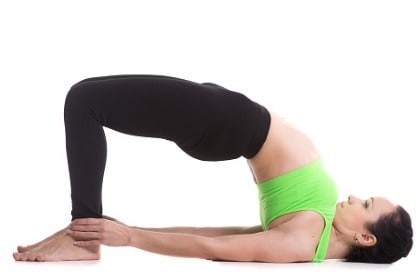
Physical Benefits – Stretches spine and neck, opens chest and lungs, stimulates the thyroid, good for tired, aching shoulders and back.
Improves digestion, reduces fatigue and insomnia, stimulates abdominal organs, relieves menopausal symptoms, and if done supported with pillows, relieves menstrual cramping.
Mental Benefits – Calming to the nervous system; eases anxiety, stress, and depression.
Cat/Cow Pose (Marjaiasana and Bitilasana)
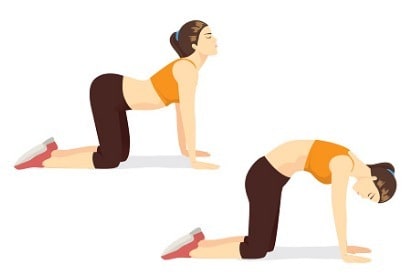
Physical Benefits – These two poses help to keep the spine flexible and massage the joints and tissues all around the spine, stretch the chest, hips, and lower back, stimulate both the sympathetic nervous system and parasympathetic nervous system.
Improves posture, eases lower back pain and sciatica, and improves the cardiovascular system.
Mental Benefits – Helps to balance both sympathetic and parasympathetic nervous systems, calming and easing stress and anxiety.
Child’s Pose (Balasana)
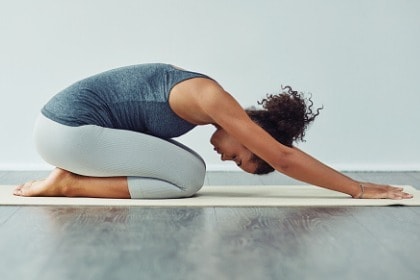
Physical Benefits – Stretches legs, spine, and lower back. Helpful for menopause because it’s calming to the nervous system and brings fresh blood circulation to the pelvic region.
Mental Benefits – Eases tension; calming and nourishing for nerves.
Corpse Pose (Savasana)
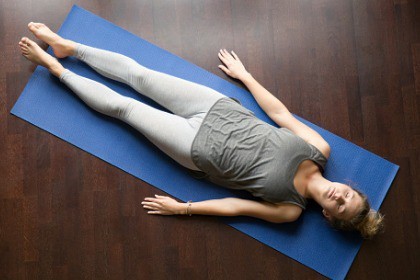
Physical Benefits – Hold this posture for at least 10 minutes for the best results. This is the best pose for finishing your yoga practice. It integrates what you’ve just done, recalibrates the nervous system, and restores energy.
Deeply calming, corpse pose slows the heart rate, promotes good digestion, eases the incidence of hot flashes and night sweats, and gets the body ready for sleep.
Mental Benefits – Eases tension and anxiety; promotes calm, clear thinking.
Dolphin Pose (Catur Svanasana)
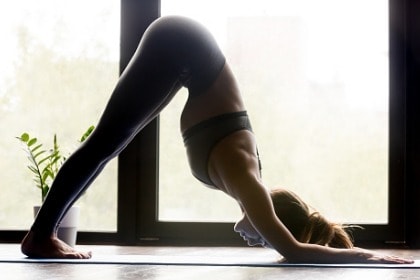
Physical Benefits – Stretches tight shoulders, eases back pain, stretches calves and posterior thighs, strengthens arms and legs, and helps prevent osteoporosis.
Relieves menopausal symptoms, eases headaches, and improves digestive function. If performed with the head supported, it helps ease menstrual discomfort. Good for insomnia.
Mental Benefits – Calming to the nervous system; eases depression, fatigue, and stress.
Downward Facing Dog (Adho Mukha Svanasana)
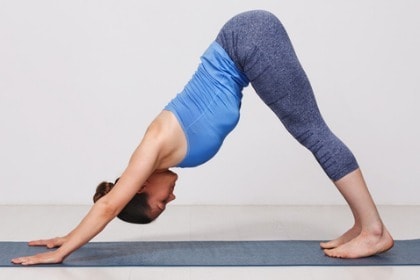
Physical Benefits – Stretches posterior thighs, calves, shoulders, wrists, and feet. Strengthens arms and legs and helps prevent osteoporosis.
Energizes and helps to combat fatigue, stimulates all of the glands of the endocrine system, and helps to balance hormone levels. Improves digestion, relieves headaches, insomnia, and back pain. When done with the head supported, it helps to ease menstrual cramping.
Mental Benefits – Enhances memory and alertness; eases stress and depression.

Eagle Pose (Garudasana)
Physical Benefits – Improves sense of balance, strengthens legs, low back, and ankles; eases the heat of hot flashes.
Mental Benefits – Increases concentration and clarity.
Easy Pose (Sukhasana)
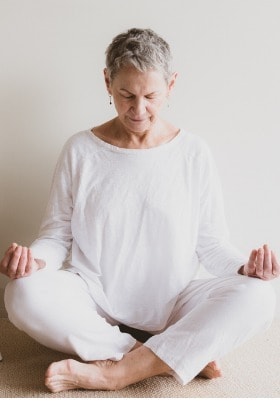
Physical Benefits – Helps to stabilize fluctuating hormones, eases menstrual cramps, stretches inner thighs, hips, ankles, and knees. Lengthens the back and spinal muscles.
Mental Benefits – Eases anxiety, promotes feeling grounded, great pose for meditation
Extended Triangle Pose (Utthita Trikonasana)

Physical Benefits – Strengthens and stretches knees, ankles, and thighs, opens hips, stretches posterior thighs and calves, relieves tight shoulders, back, and neck.
Stimulates abdominal organs, improves digestion, and relieves menopausal symptoms.
Mental Benefits – Relieves stress and tension
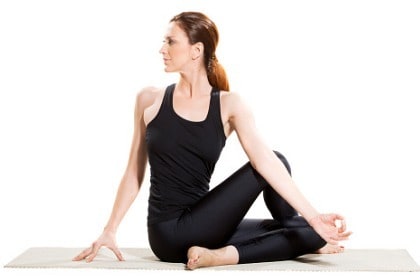
Half Lord of the Fishes Pose (Ardha Matsyendrasana)
Physical Benefits – Stretches and energizes the spine, shoulders, hips, and neck. Stimulates digestion, liver, and kidneys, relieves backache, sore neck, and fatigue.
Mental Benefits – Energizing yet calming; improves clarity of thought.
Head-to-Knee Forward Bend (Janu Sirsasana)
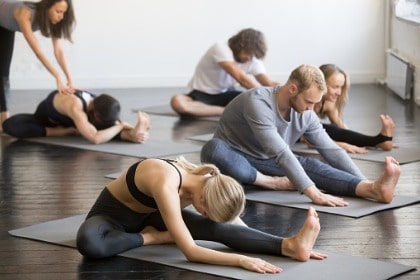
Physical Benefits– Stretches posterior legs, spine, shoulders, and neck. Stimulates the liver, improves digestion, relieves symptoms of menopause and menstrual cramps, eases headaches and insomnia.
Mental Benefits – Calms the nervous system; relieves depression and anxiety

Hero Pose (Virasana)
Physical Benefits – Helpful prior to bed to encourage more restful sleep. Stretches thighs, knees, ankles, and feet. Improves digestion and relieves menopausal symptoms.
Mental Benefits – Calming and centering.
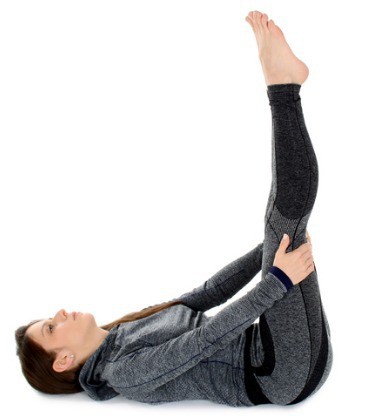
Legs-Up-The-Wall Pose (Viparita Karani)
Physical Benefits – A gentle inversion; helps to promote sleep, eases digestive problems, and headaches. Good for varicose veins.
Mental Benefits – Promotes peace and calming; helps mild depression and anxiety.
Low Lunge Pose (Anjaneyasana)
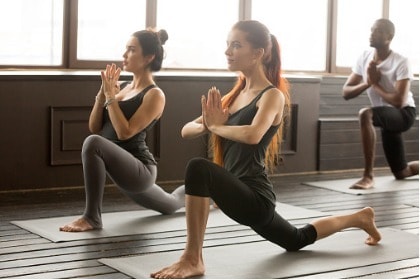
Physical Benefits – This pose is great for people who sit too much. It stretches muscles deep within the pelvis, helps ease lower back and hip pain. Promotes circulation in the pelvic region.
Mental Benefits – Releases tension and anxiety.
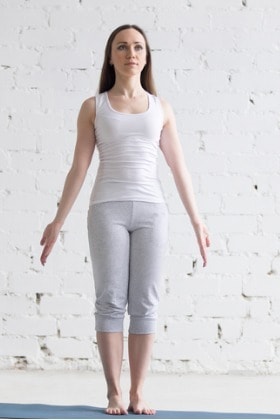
Mountain (Tadasana)
Physical Benefits – Steadies breathing, helps ease hot flashes, improves posture and balance, firms tummy and hips.
Mental Benefits – Improves focus and calms the mind.
Plow Pose (Halasana)
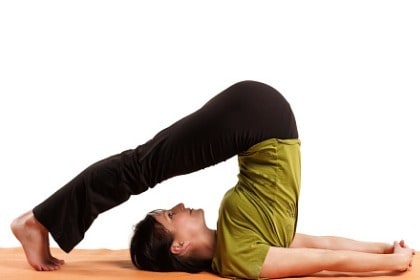
Physical Benefits – Stimulates pelvic region and thyroid, balances hormones, stretches shoulders and spine, eases backaches and headaches; may help insomnia.
Mental Benefits – Reduces stress and fatigue and calms an overactive brain.
Reclining Bound Angle Pose (Supta Baddha Konasana)
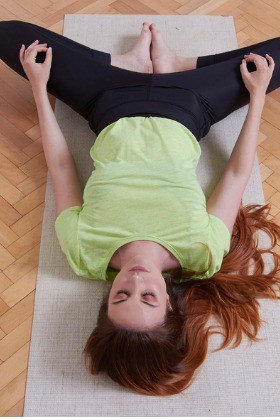
Physical Benefits – A restorative pose that calms overactive adrenals, helps balance hormones, eases incidence of hot flashes, stretches inner thighs and knees, and stimulates and oxygenates the pelvic region. Eases menstrual cramping, stimulates kidneys and heart, improves circulation, eases insomnia, fatigue, and lethargy.
Mental Benefits – Relieves stress; eases depression.
Reclining Hero Pose (Supta Virasana)
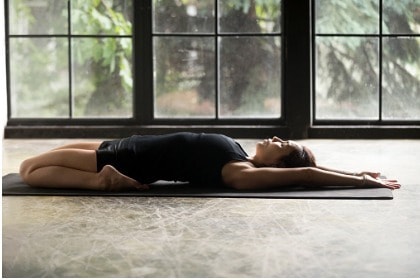
Physical Benefits – Deeply stretches abdomen, thighs, knees, ankles, and hip muscles, and stimulates the circulation of blood in these areas. Eases tension in the pelvic area, helps menstrual discomfort, eases hot flashes, high blood pressure, headaches, insomnia, and fatigue, and improves digestion.
**This pose is not for beginners unless using plenty of bolsters or cushions to support you. Best performed in a class with a qualified instructor.**
Mental Benefits – Calms an over-busy mind, improves clarity, and eases tension.
Seated Forward Bend (Paschimottanasana)
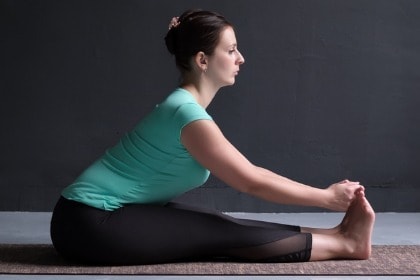
Physical Benefits – Stretches back, shoulders, neck, and posterior thighs. Stimulates adrenal and pituitary glands, promotes estrogen, improves digestive function, and eases headaches and fatigue.
Mental Benefits – Calms the nervous system, eases stress, anxiety, and mild depression.
Seated Wide Angle Pose (Upavistha Konasana)
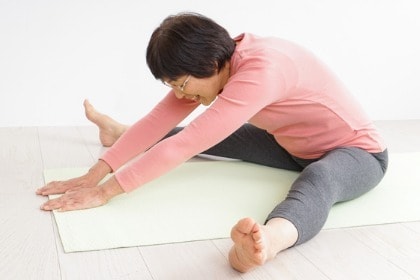
Physical Benefits – Stretches inner and posterior thighs, increases circulation in the pelvic region, lifts and tones uterus, promotes estrogen, strengthens the spine. At first, this pose might seem difficult, but it’s all about surrendering and allowing the stretch to happen.
Mental Benefits – Calming; promotes peaceful feelings.
Standing Forward Bend (Uttanasana)
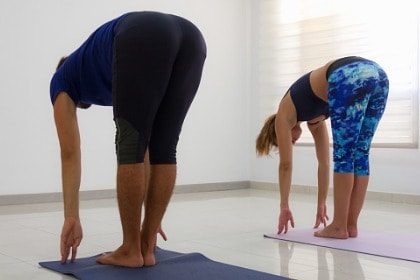
Physical Benefits – Stretches and strengthens posterior thighs and calves, opens hips, stimulates liver and kidneys, helps digestive problems, reduces fatigue, eases insomnia and headaches.
Mental Benefits – Calming to the nervous system, relieves stress and anxiety, irritability, and mild depression.
Sun Salutation (Surya Namaskar)
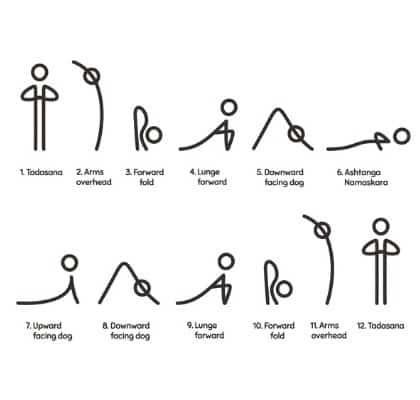
Physical Benefits – A sequence of several yoga poses, Sun Salutation increases energy, promotes better circulation, increases flexibility and suppleness; works almost every muscle of the body. It’s superb when you don’t have much time for yoga. Just doing 5-10 rounds gives dramatic results.
Mental Benefits – Promotes mental stability and feelings of wellness and peace.
Tree Pose (Vrksasana)
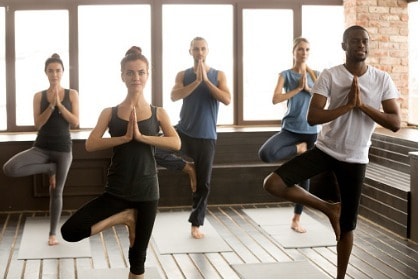
Physical Benefits – Improves balance; strengthens legs, ankles, and spine. Helps ease intensity of hot flashes.
Mental Benefits – Promotes feelings of peace and clarity.
Warrior 1 Pose (Virabhadrasana)
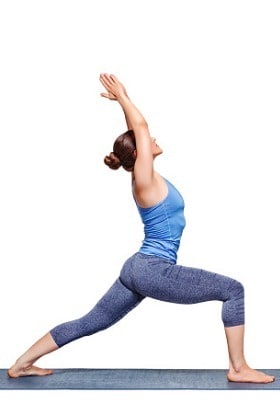
Physical Benefits – Stimulates the thyroid, stretches the chest, shoulders, neck, and deep hip flexors.
Strengthens thighs, calves, ankles, and hips. Great for improving bone density and muscle tone.
Mental Benefits – Eases anxiety, nervousness, and stress.
Wide-Legged Forward Bend (Prasarita Padottanasana I)
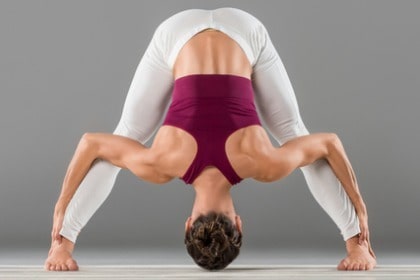
Physical Benefits – Stretches both inner thighs and posterior thighs, which tend to shorten and tighten with age.
Also lowers blood pressure, increases oxygenation to the brain, tones muscles in the abdominal region, eases backaches, and tension headaches.
Mental Benefits – Calms an overactive mind, relaxes, eases anxiety and irritability.
Are You Doing Yoga Poses for Menopause?
As you can see, yoga exercises for menopause not only provide relief from menopausal symptoms, but they can also strengthen the body and improve health in a variety of ways.
If you feel as though your body and mind are spiraling out of your control, get yourself into a yoga class and reclaim your health. The rewards of yoga for menopause will benefit you not only through the peri- and post-menopause journey but all through your life.
Organixx Menopause Balance + Glow is a USDA Organic, plant-based blend of adaptogens, botanicals, and superfoods—each carefully chosen to work synergistically to support women’s health and wellbeing during the natural transition from pre- to post-menopause.
What truly sets Menopause Balance + Glow apart is how comprehensively it supports the whole woman—not just hormonally, but cognitively, emotionally, and physically. This formula doesn’t simply aim to help reduce hot flashes or night sweats; it helps maintain a healthy libido, mental clarity, immune function, energy, and skin and hair vitality.*
*These statements have not been evaluated by the Food and Drug Administration. This product is not intended to diagnose, treat, cure or prevent any disease.

 Sources:
Sources:
Article Summary
A woman is considered to be in menopause when she has not had a menstrual period for one year. The transition generally takes several years with the phase leading up to it called perimenopause.
Fluctuating levels of the hormones progesterone and estrogen can spark many uncomfortable symptoms during this time.
Many women going through menopause notice their menopausal symptoms are improved when they regularly practice yoga.
Research shows that yoga can help in the following ways:
- Reduced frequency & intensity of hot flashes
- Less anxiety
- Better sexual function
- Improved quality of life
- Improved psychological symptoms
See the article for a list of common menopause symptoms, along with the particular yoga poses or types of poses that are most likely to help.


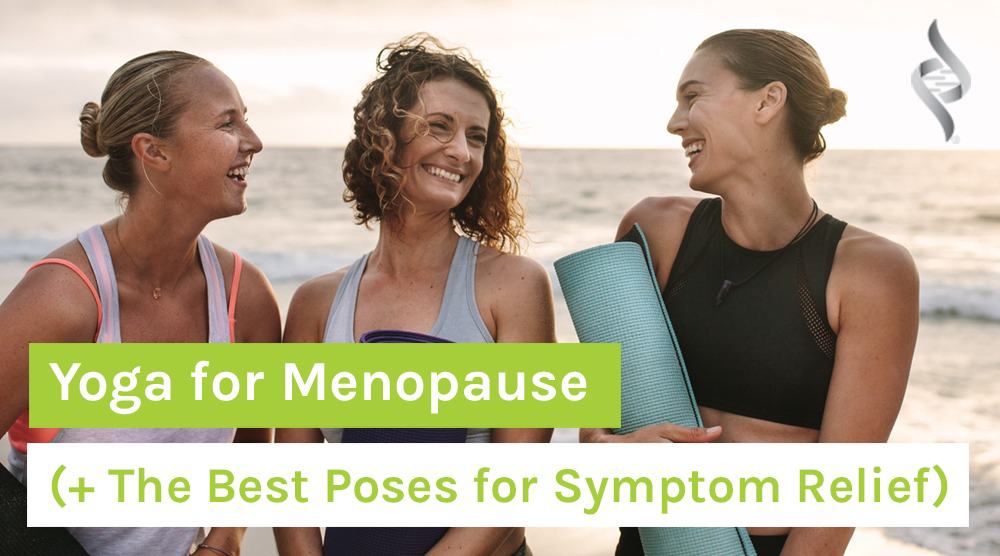
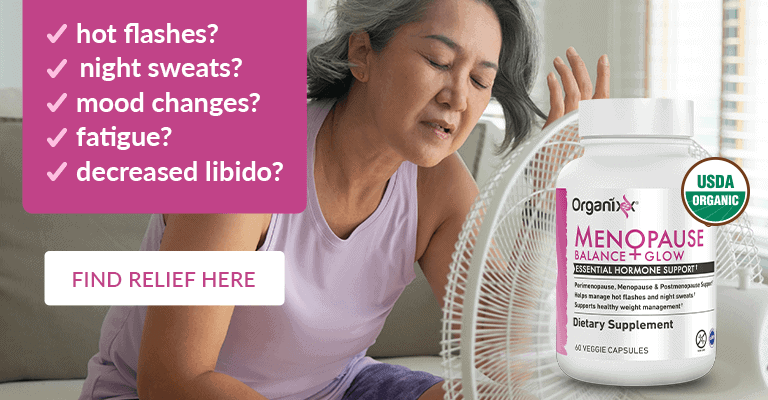
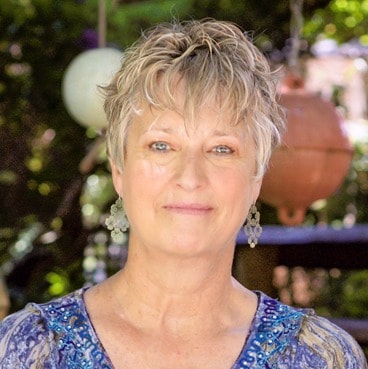
Hello! Is there anywhere I can go in your website, or could this article be re-published to include a photo of each yoga pose that is described? It would be super helpful to try these poses with a photo included such as some of them in the article.
Otherwise, I guess I will need to get out my yoga book, take the time to look up each pose while having your article open on my browser to try the poses suggested in the article. Can we shorten the process? Could this article be re-published and include photos of each yoga pose described please? Thanks!
Hi Leslie, thank you for your suggestion.
We were able to implement your idea of adding more photos. Please keep in mind that guidance in learning the poses is an excellent idea and never to push your body beyond what it is capable of doing.
Thank you for being here with us. We hope you have a wonderful day.